Original translation: Block unicorn
Original translation: Block unicorn
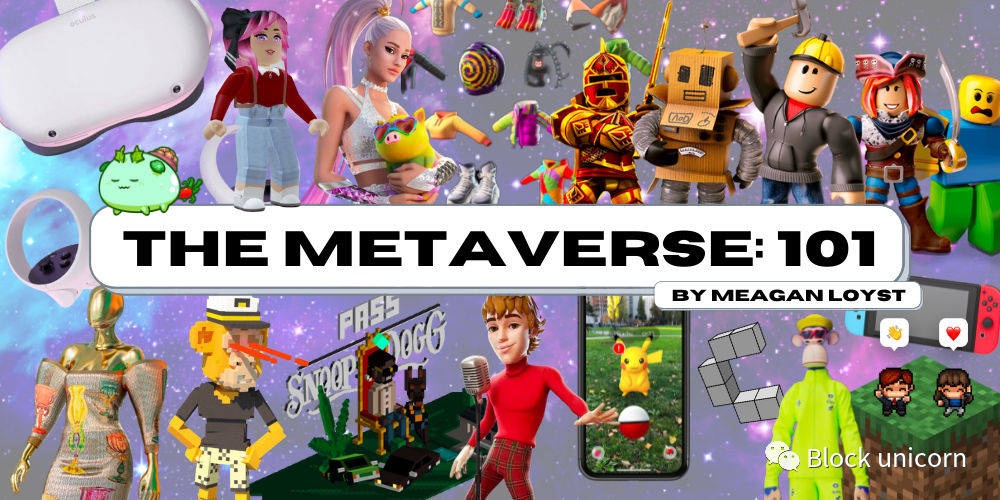
So what exactly is the metaverse?
Despite its recent rise to fame, the term Metaverse was first coined 30 years ago in 1992 by science fiction author Neil Stephenson. His novel Snow Crash depicts the Metaverse as a 3D virtual world where people move around as avatars, socializing/interacting with each other, as well as AI-generated characters.
image description
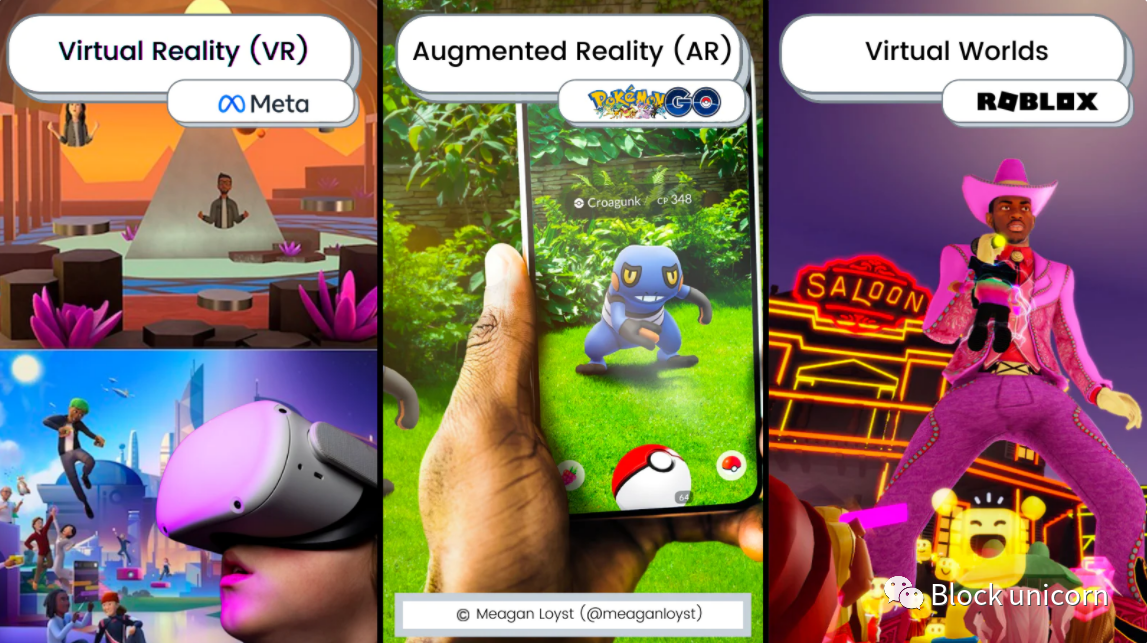
virtual reality (VR)
These are immersive worlds where you can touch, feel and move in a digital world through headsets and haptic technology, aka: physical senses and representations in a digital world.
Facebook rebranded itself "Meta" in October 2021 to create its own version of the Metaverse and spent $10 billion to bring it to life. The core gameplay of their virtual reality Horizon World is a social world-building playground accessible using Meta's Oculus headsets -- which expanded from an invite-only beta in December 2021. On Christmas Day, Oculus was the No. 1 free app on Apple's App Store, proving renewed interest in experiencing virtual worlds through VR.
Augmented Reality (AR)
It's an interactive experience that takes place in the physical world, overlaid with computer-generated objects and environments, aka: digital representations in the physical world.
Back in 2016, Pokemon GO (created by Niantic) took the world by storm, reaching 232 million users at its peak, with the core experience taking place in augmented reality. Players can move around the real/physical world to catch the featured Pokemon in the phone app, which can appear anytime, anywhere.
virtual reality
virtual reality
This is the most open interpretation of the metaverse, where traditional games with avatars, skins, economies, and social platforms can be considered metaverses in their own right. Namely: Microsoft CEO Satya Nadella claims, "If you think of Halo as a game, it's a metaverse. Minecraft is a metaverse." Except for newer game variants that now host virtual concerts like Roblox or Fortnite. Outside of the Metaverse, there are games and worlds being built on the blockchain (ie: Axie Infinity, Sandbox) that are able to create new ecosystems and worlds that help bridge the digital and the physical. AKA, the fully digital world, with a digital representation.
Roblox has become a metaverse darling for everyday non-crypto consumers, with half of US children reportedly playing games on Roblox, where users can play millions of 3D online games, customize their avatar with skins, and spend/earn Robux. Roblox also has the most monthly active users (202 million as of April 2021), and strong daily engagement on the newer-age Metaverse platform (nearly 50 million DAU as of December 2021). Roblox is a closed ecosystem, which means that avatars and skins in Roblox cannot be ported outside of the game. It's a platform thriving on UGC - as of October 2021, Roblox has 1.3 million developers earning Robux (the in-game currency), and these creators are expected to earn $500 million from their game creations this year. With a $61 billion market cap, Roblox is one of the most highly valued companies in the metaverse, and I think it's still in the early stages of capturing value from brands, franchises, and the artists on their platform.
The Sandbox is a blockchain-based virtual world (built on Ethereum) where players can build, own and monetize their gaming experience. There is a fixed number of NFT-based real estate plots in the game (two-thirds of which have been sold), and companies, celebrities, and individuals are all vying for their rights in these plots. As of November 2021, The Sandbox's total land commodity value has exceeded $144 million, with more than 12,000 virtual land owners (including 165 brands and more than 500,000 registered wallets). The company just raised $93 million from SoftBank’s Vision Fund, citing ambitions to “grow from gaming to an economy in fashion, architecture, virtual concerts and performances, art galleries, museums, and more.” The Sandbox is utilizing a "earn as you play" model to incentivize the time players spend in the Metaverse, and is building an open Metaverse to enable greater collaboration with creators and brands alike.
first level title
image description

The "metaverse" starter pack for Gen Z, especially those born in the late 90s/early 2000s
therefore,
therefore,If the "Metaverse" has been around for years, what's so special about it this time around?I think market timing, technology (blockchain, headsets) and generational readiness play an equal part here. I'll dive into all three from my perspective, but first, I'll review some thoughts on why previous Metaverse startups failed, starting with Second Life.
Founded in 2003, Second Life is an overhyped metaverse startup struggling to stay relevant - I don't think many of the younger generation have even heard of it, despite being hyped almost 20 years ago as being as important as Facebook or Revolutionary. Similar to today's metaverse startups/companies, in Second Life's virtual world you can roam around and customize your own digital avatar, attend events, buy and sell virtual goods, and more. At their peak in 2007, they had around 1 million monthly members and even saw brand collaborations with Adidas, Armani and Calvin Klein (which sounds very familiar given the Roblox events we're seeing now).
The biggest difference between the failed Second Life and the success of Roblox was that Second Life wasn't actually a game and failed to create the mechanics to keep users engaged. Dedicated Second Life user and blogger details "Its users primarily use it for social gaming activities such as cosplay, virtual fashion, collaborative sandbox building, and even virtual sex." The average age of Second Life users is 32, So it's naturally an older demographic, and the use case is fundamentally different than that of Roblox/Fortnite - even the ex-chief architect of Second Life claimed "there's a reason why it didn't [work] that's still very true today, It’s just that most adults aren’t used to interacting or socializing with new people in a multiplayer online environment.” User-generated content also hasn’t received the same attention from VCs as it does today in the post-YouTube world, and Second Life’s platform is said to be difficult to create /build, which creates friction. Compare that to Roblox, 24.5% of all revenue generated by games, with $250 million in 2020 and $500 million in 2021 spending.
You can also turn to the failed promises of many of the VR startups of the past decade that raised millions of dollars in funding but weren't quite ready for prime-time consumer adoption. VR startups raised $900 million in 2016 but plummeted to $280 million by 2018 as many failed to deliver. In recent years, Oculus has regained favor. Examples: Facebook rebrands to Meta, Oculus jumps to #1 free app in the iOS App Store this Christmas, and more.
There were plenty of other blockchain-based games that failed before the rise of Axie Infinity (again... existing since 2018 but wildly successful in 2021), and this article details some of them and explains how Associated unique challenges to Ethereum gas prices and create friction within the platform. Axie solves this problem with the Ronin sidechain wallet. As with investing in any traditional gaming startup, there is some "hit risk" inherent.
So, we're back to the question, why now? I think it's a combination of these three forces:
1. Market Timing
2. Technology (Blockchain, Devices)
3. Prepare for Gen Z.
Market Timing - COVID-19 / Pandemic
It's hard to ignore the impact of the pandemic and stay-at-home orders on the growth of the Metaverse. People of all ages must become more comfortable living digitally and doing things from home—whether it’s working, ordering groceries, visiting the doctor or veterinarian via telehealth, or even spending time with friends and family on Zoom or FaceTime. Even on a personal level, I never had an online friend before 2020 - the growth of Twitter and my own global online community of Gen Z VCs contributed to this. I've also never worked from home, attended a virtual concert, or used Zoom outside of a work environment (I can now say I've attended weddings, baby showers, etc.).
Facebook changed its name to Meta
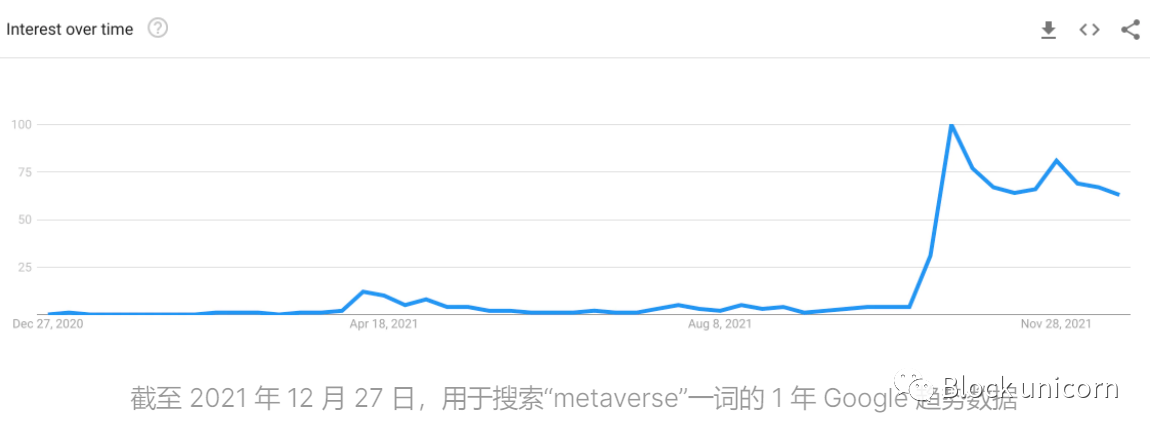
technology
technology
Today you can experience the metaverse in many different forms, from web-based metaverses such as Roblox, console-based metaverses such as Animal Crossing via Nintendo Switch, and VR-based metaverses via Oculus such as Meta’s Horizon Worlds or VRChat, or even through your iPhone for AR-based metaverses like Pokemon GO.
I would say that from an investment standpoint, I am more bullish on web-based virtual worlds and metaverses, mostly because I think they have the least friction in terms of achieving mass adoption. You can use Oculus and Nintendo Switch and Roblox for quick level setup. Oculus is said to have sold 10 million Quest 2 VR headsets in the past year (through December 2021), making it the most successful VR headset in the world. However, it still pales in comparison to the 97 million Nintendo Switch consoles sold (and the 35 million copies of Animal Crossing currently in consumers' hands via the Switch)...not to mention the 50 million copies played every day on Roblox. Active users do not need any additional hardware to play. To put these numbers in perspective, there are more daily active users on Roblox (50 million) than the entire population of Spain (47 million).
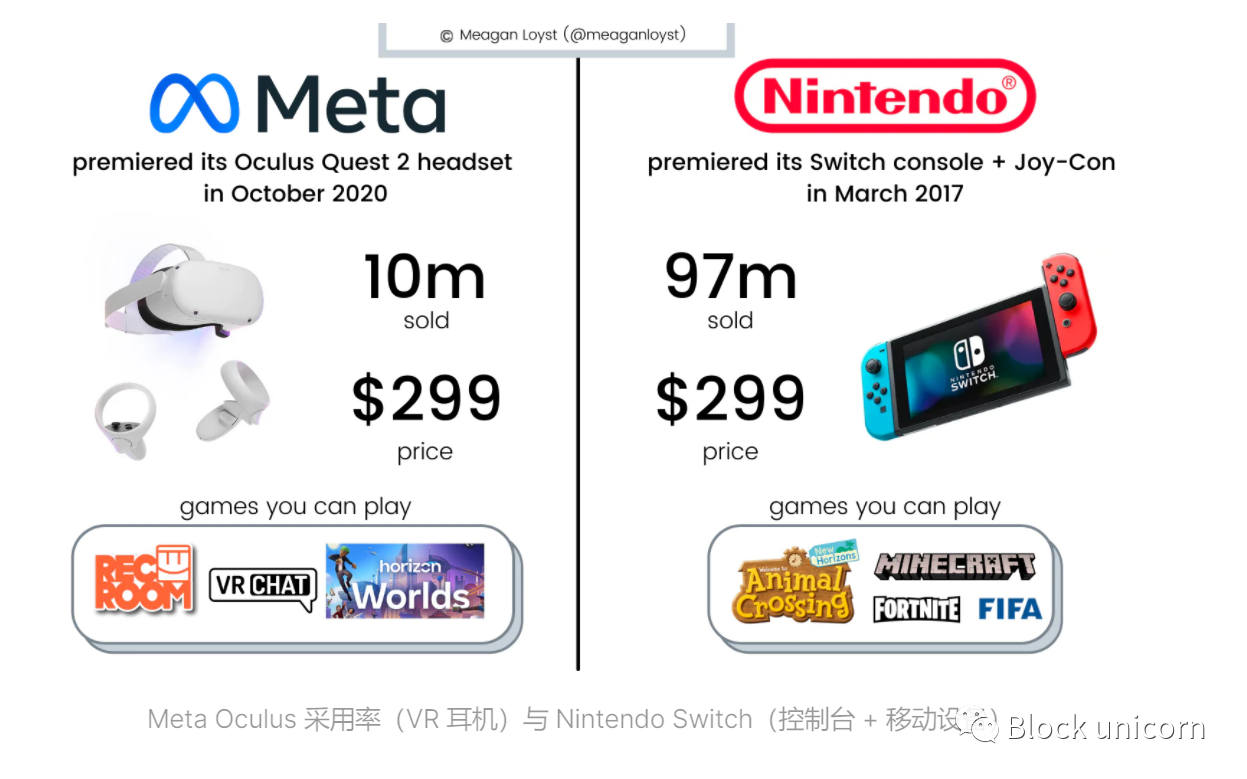
That said, many more technological advances will be required before we'll be able to work, live, and play in the Metaverse for days on end. As a data point, I've spent the past 2 days reading and writing about Metaverse almost entirely on my computer. I'm about halfway through my blue light glasses and I still get headaches and need a break from looking at my screen. I think we'll need years to work, live and play in the Metaverse (especially VR) for days.
Gen Z Ready
image description

Top new-age metaverse platforms by MAU and average user age (primarily Gen Z).
I've been a clear advocate of Roblox's success and continue to delve into case studies of partnerships in fashion, music/concerts, and more. However, if you look at the largest web-based virtual worlds or metaverses by user base (ie: Roblox, Fortnite, Minecraft)...the vast majority are Gen Z. We're so used to our digital lives that the metaworld really isn't a new concept. The younger generation is embracing the monetization opportunities that come with these types of resale economies, and Club Penguin or Webkinz didn't exist for us. Gen Z is all about side hustles and entrepreneurship, platforms that allow us to be creative, build/create, and make money through ownership. Earlier this year, there was a study that showed that people spend 5 times more in blockchain-based games than in traditional games.
Jamie Burke perfectly described this phenomenon in the context of Axie Infinity's recent success, saying: "When that value can be freely transferred outside the platform and the value earned or purchased can be easily converted into a crypto such as Bitcoin or Ethereum Players will spend more money in the game when they have currency.” This is the core difference between having Webkinz in the digital world and having Axie in the digital world.
As Gen Z gradually transitions from Roblox to other metaverse platforms, real opportunities are created for metaverses like The Sandbox, Decentraland, etc. to own this audience and monetize accordingly, or other blockchain-based games to win over younger audiences The heart is eager to play and make money.
first level title
Early adopters in metaverse and use cases
Fashion in the Metaverse
When it comes to bridging the gap between the digital and physical worlds, fashion seems most poised to embrace the metaverse, a year of frenzied collaborations and activations across platforms from Vans, Nike, Ralph Lauren and more It proves this, Balenciaga, Gucci, Uniqlo and so on.
Why Skins Create Opportunities for Brands
Luxury and mass retailers should care about the Metaverse because one of the biggest opportunities for in-game monetization is through skins, which are customizable add-ons that allow you to change the appearance of your avatar (e.g. clothing, accessories, etc.). With a reported $40 billion a year fur market, it's hard to ignore. You combine this $40 billion market opportunity with this emerging theme of "meet users where they are," which in many cases, in gaming ecosystems like Roblox or Fortnite, you have a magical brand moment, Reach your target audience in a way that is authentic and authentic and profitable. And all this without the physical constraints of production in the physical world — you could theoretically create garment pieces without the constraints of gravity, without worrying about overstocking or discounting, or changes in labor costs. Take digital fashion house The Fabricant and how they make digital clothing pieces and collections. For Australian Fashion Week, The Fabricant brought to life the Animator coat, "made of liquid metal and enhanced with gravity-defying tentacles," something that can't be physically replicated in the real world.
secondary title
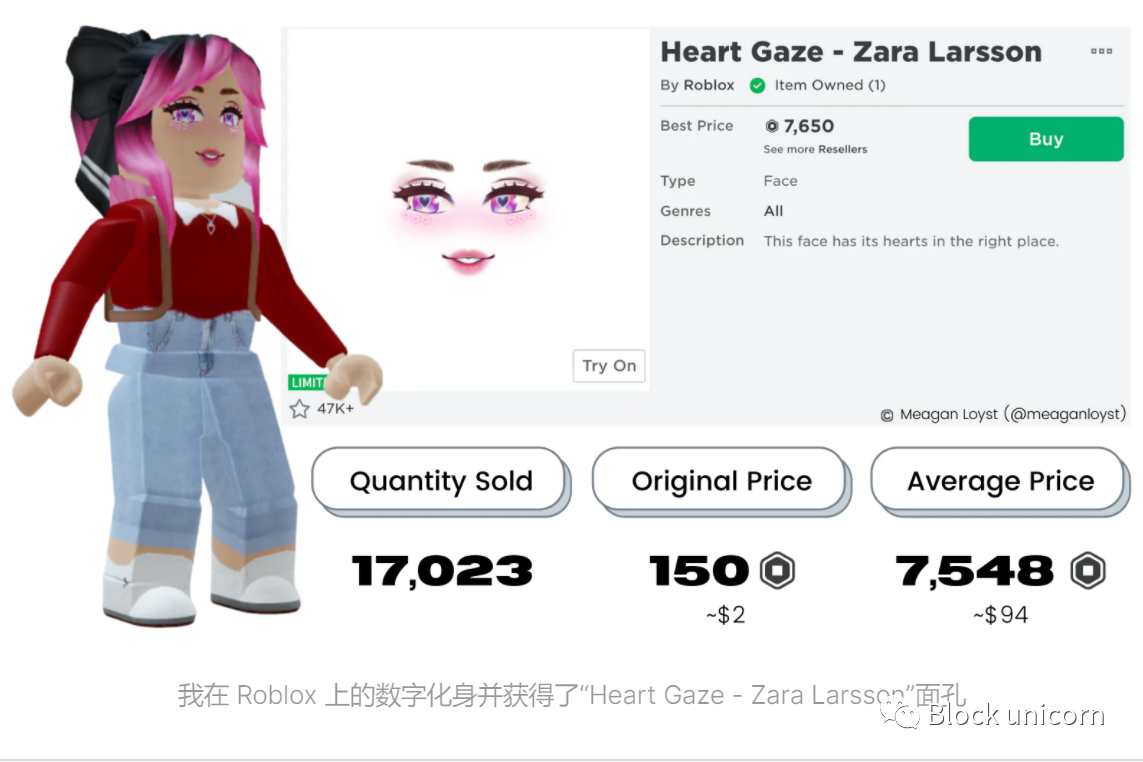
Brand Collaborations in the Metaverse: 2021 Edition
image description
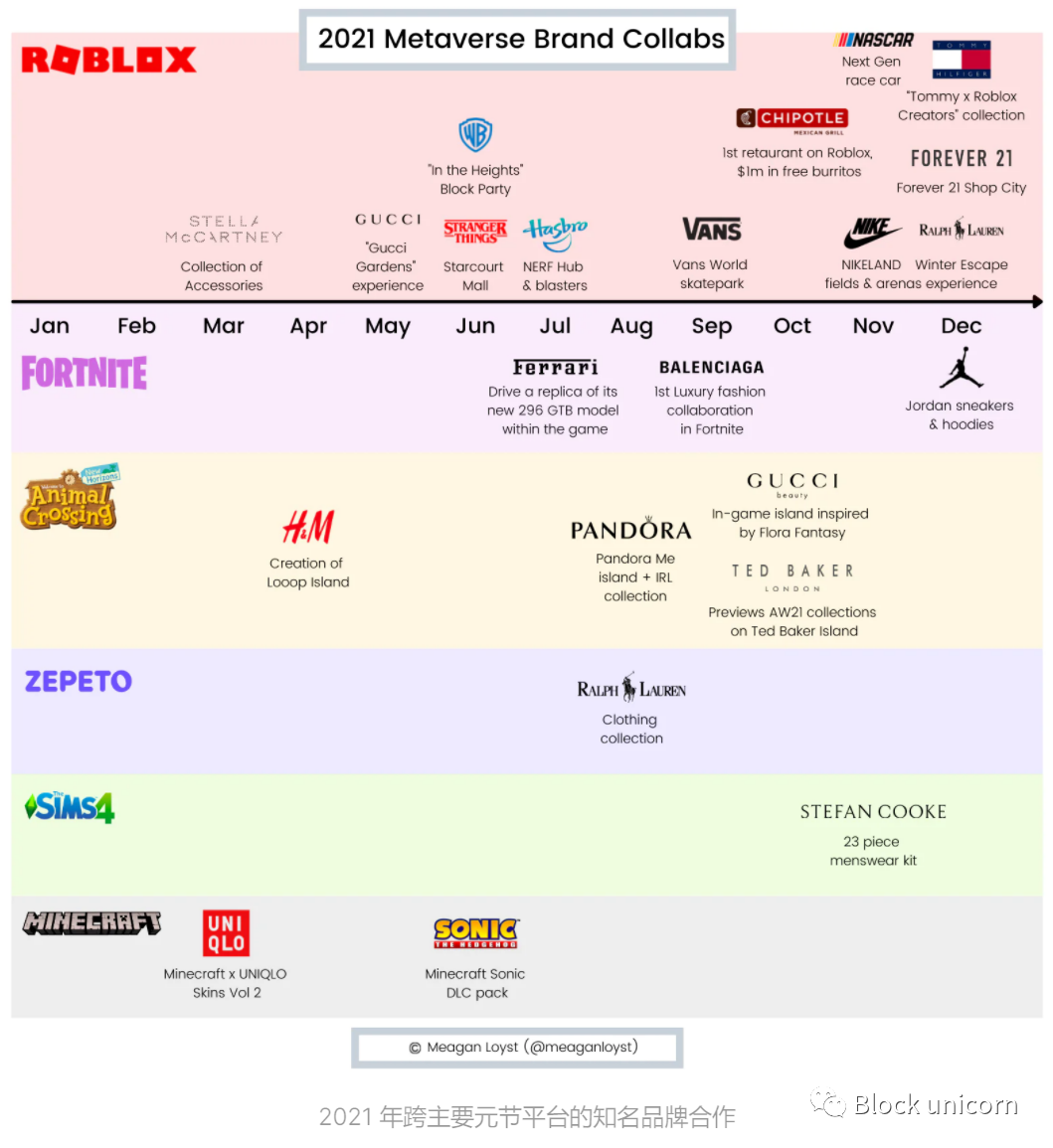
2021 major metaverse platforms and well-known brand cooperation
Many of these are developed through Roblox's team of partners / "top down" not directly to the game developers but themselves. Additionally, big brands often work with agencies or consultants to help with some of these larger collaborations. Forever 21 partnered with Metaverse creation company Virtual Brand Group to help them launch their "Shop City" experience in Roblox, allowing users to create their own fashion store (I live-streamed this partnership on Bloomberg TV if you want to know More info in December). These events also range from short-term real-life/virtual collaborations such as the Gucci Gardens experience on Roblox that lasted only 2 weeks, to long-term or indefinite collaborations such as Vans' Vans World skate park on Roblox. In contrast, when you consider activations in The Sandbox, brands are more likely to always have a longer term presence as they would need to acquire land/real estate to have a virtual presence, which may only increase over time given scarcity Add value over time on the platform (versus the limitless potential to launch new games or experiences in Roblox).
I believe there is a huge opportunity for the 1.3 million Roblox developers (and independent UGC creators on other Metaverse gaming platforms) to directly bring these experiences to life and the technology that might help make this happen. For example, when a brand approaches a game developer to customize an experience, there's a ton of legal work, insurance, and things that these small teams or individual developers need to consider. It's about the creator economy and tools that support the next generation of creators...and I bet many of those creators will be gamers. Here are some early examples of well-known brands collaborating with creators to bring their visions to life in the Metaverse:
Vans World collaborated with Roblox game studio Gang Stockholm to create a Vans skate park based on the real Vans space.
Gucci created the product in collaboration with designers cSapphire and Rook Vanguard, creators of Roblox with a popular following.
Stella McCartney teamed up with community creator Samuel Jordan, known as "Builder Boy" in his virtual collection.
Tommy Hilfiger let the creators of Roblox play their part in designing the series. Namely: @PolarcubArt took over the Tommy Jeans backpack, while @MiracleDropsRBX designed a nylon messenger bag and a unique skateboard.
NASCAR partnered with a 2-person development team (Badimo) to create a 10-day campaign on their hit game Jailbreak, which attracted 24 million users throughout its activation.
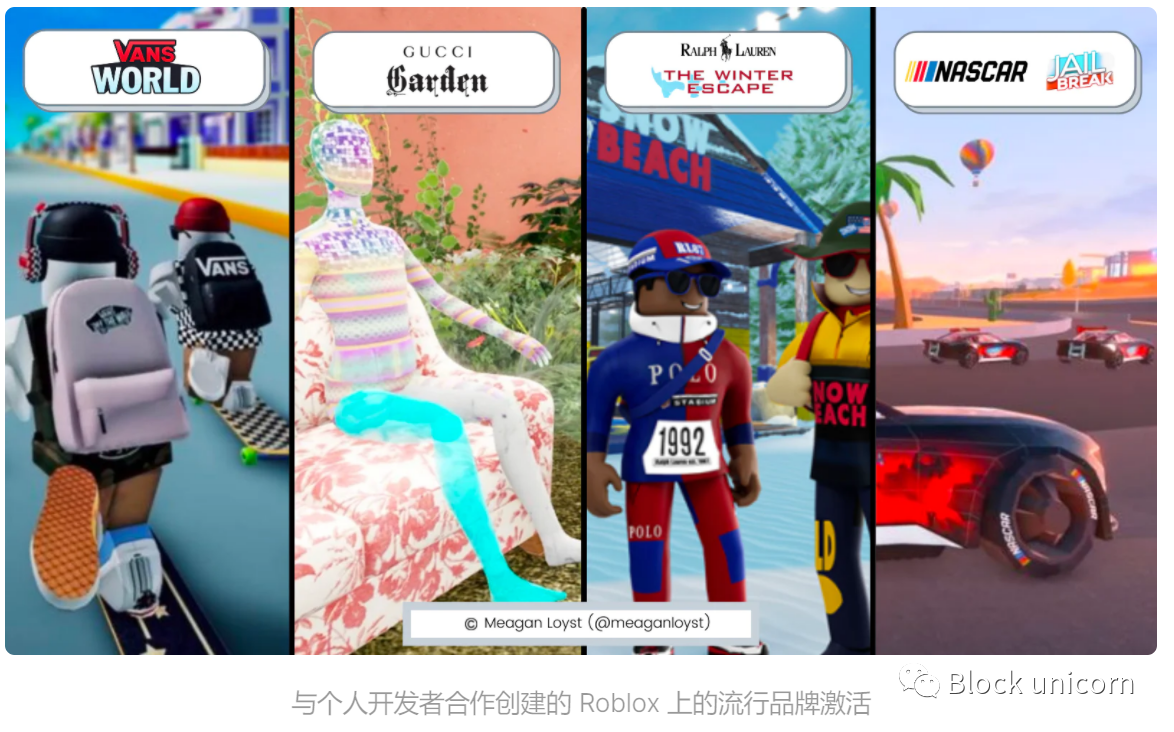
Brands can also create their own gaming experience if they prefer to own and monetize the end-to-end experience, as we will see in 2021 with brands like Off-White, Selfridges, Balenciaga and Louis Vuitton.
Just because a brand activates in one metaverse doesn't mean they will partner with another. For example, Balenciaga created their own virtual experience on Epic's Unreal Engine Afterworld to launch their Fall '21 collection, and then did a massive activation for Fortnite later this year. Ralph Lauren also launched a collection in Zepeto's metaverse, and then launched a full Winter Escape experience in Roblox, complete with skins. This is largely because different age groups come together in different metaverses, so by securing cross-platform partnerships, brands are able to reach multiple audiences.
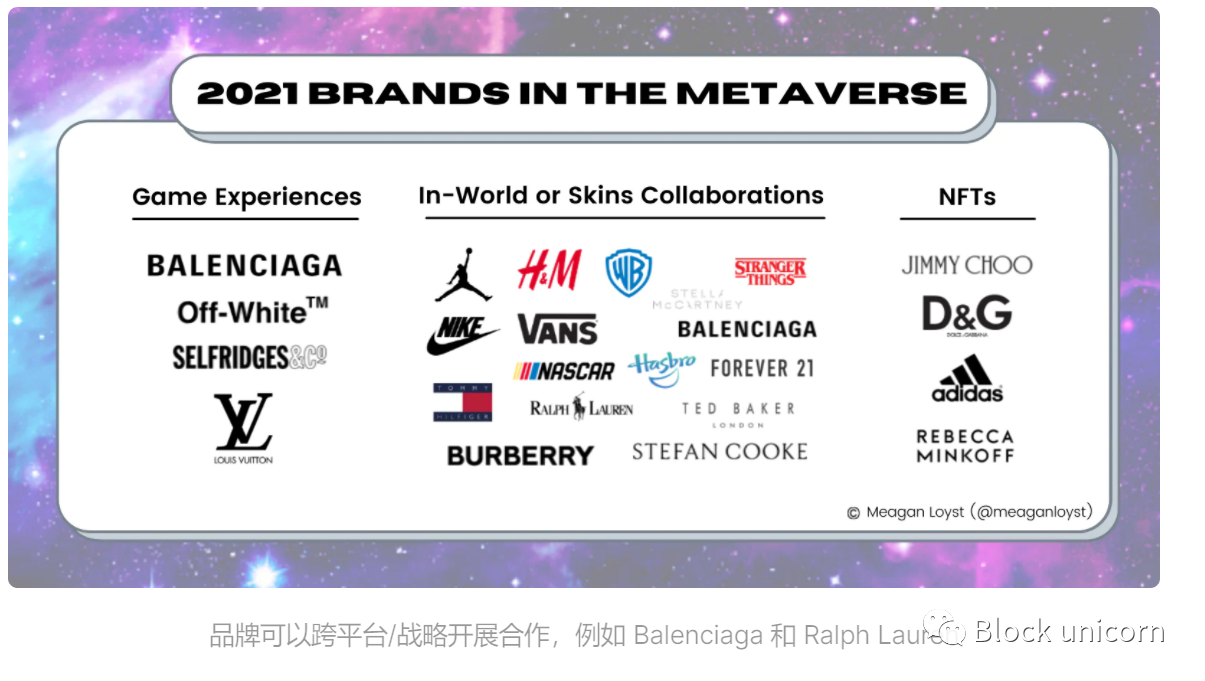
Expect more brands to venture into the Metaverse in 2022, whether by creating virtual lands and experiences in The Sandbox, local experiences in Roblox, developing their own games, or launching NFT collections to eventually migrate to the Metaverse.
music in the metaverse
Virtual concerts have grown in popularity during COVID-19, taking place on platforms such as Metaverse, Zoom or Moment House/Single Music. I'll dive into three specific musician/artist events in the cross-platform metaverse, and why each event is important to an artist's earning potential and connection to their fanbase.
I also think musicians and artists will draw the most into the metaverse, because I think the music industry is more of a cult than the fashion industry. When we look at Gen Z and the obsession with creators and the amount of mega-artists like Ariana Grande, Lil Nas X and others are able to draw fans to the metaverse, it's clear that this creates a huge opportunity for metaverse platforms Same with startups.
Travis Scott on Fortnite
Fortnite has been an early winner in creating concert experiences in the Metaverse. The first Metaverse concert in memory to garner mass media attention was Travis Scott's "Astronomy" concert in Fortnite in April 2020. While Travis Scott has been a questionable figure since the Astroworld tragedy (his Fortnite skin has even been pulled from the market), his groundbreaking experience with the Metaverse remains noteworthy and offers makes a strong case study, as he was one of the first mainstream celebrities to take his fan base into the virtual world. Note: I am not a fan of Travis Scott and do not condone his actions.
The best way to demonstrate the gravitas and potential of a virtual Metaverse event is to show a side-by-side comparison of an in-person tour versus an activation in the Metaverse. The comparison below compares Scott's 2018-2019 headlining tour in North America with his 5-concert global tour in Fortnite VR.
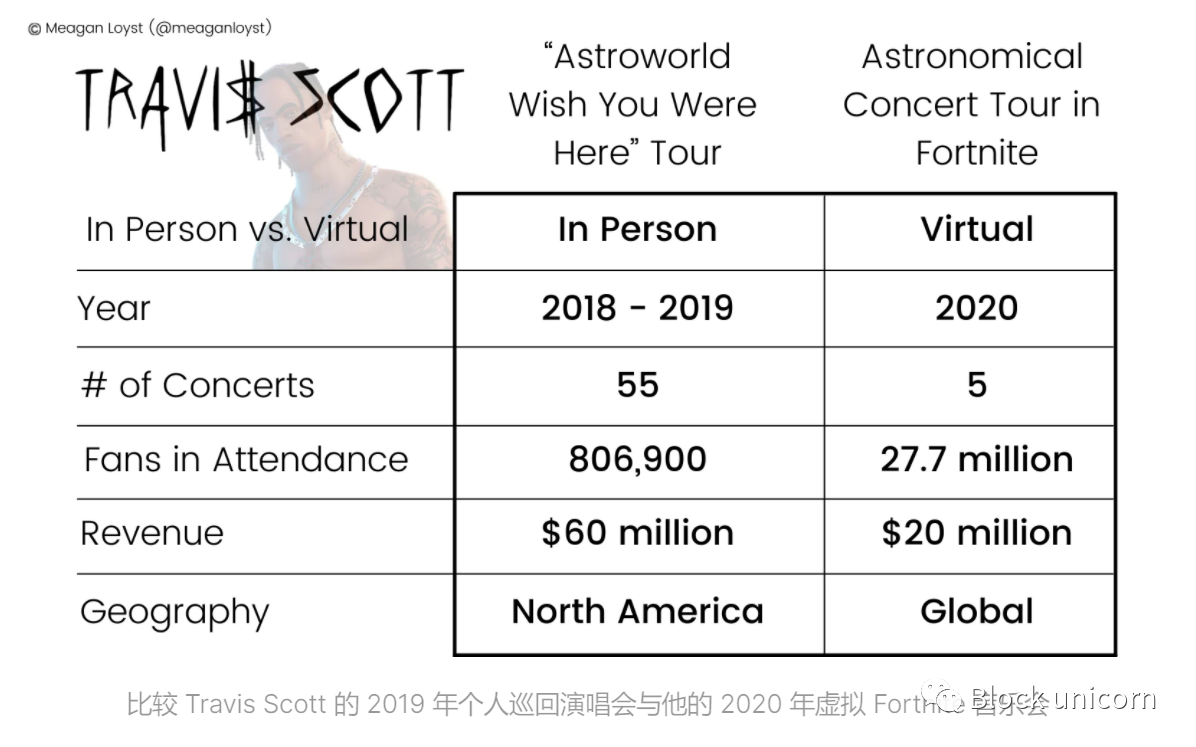
Arguably, creators' most valuable asset is their time, with each Fortnite concert running about 10 minutes in length. If you multiply that by 5, his entire Fortnite global set, it's not even an hour (and shorter than a single face-to-face show). Scott has been rumored to make $20 million from his Fortnite tour, and while that's only a third of what he earns from touring in person, let's extrapolate how much he actually makes per hour. Conservatively assuming that he spends about 2 hours on stage per concert, that means he performs 110 hours on tour, earning $545,000 per hour in person. In the Metaverse, he's actually making $24 million an hour, which means Travis Scott theoretically makes 44 times as much doing immersive concerts in the Metaverse.
Earning potential aside, he's entertaining a fan base that's 34 times bigger than he could ever do on tour in person. Metaverse is equally important for audience building, engagement with top fans, and discovery of new fans who may not be able to attend in person for various reasons. During a pandemic where global travel and touring has become more difficult than ever, Travis Scott has been able to engage his global fan base without leaving the house. And it did so in an immersive way, taking fans into outer space, underwater and everything in between. A year later, when you fast-forward to Ariana Grande's live performance in Fortnite, an estimated 78 million users watched her show (and she earned about $20 million).
first level title
Snoop Dogg on Sandbox
Snoop Dogg's role as a creator and celebrity in the Metaverse should come as no surprise, at least to the crypto community. Snoop Dogg has been an early adopter of blockchain technology, and as of September 2021, he owns about $17 million in Ethereum-based NFTs (including 9 Crypto Punks).
Unlike the Travis Scott or Ariana Grande examples above, Snoop achieved a permanent place in the Metaverse while developing the "Snoopverse" in The Sandbox...it's pretty epic.
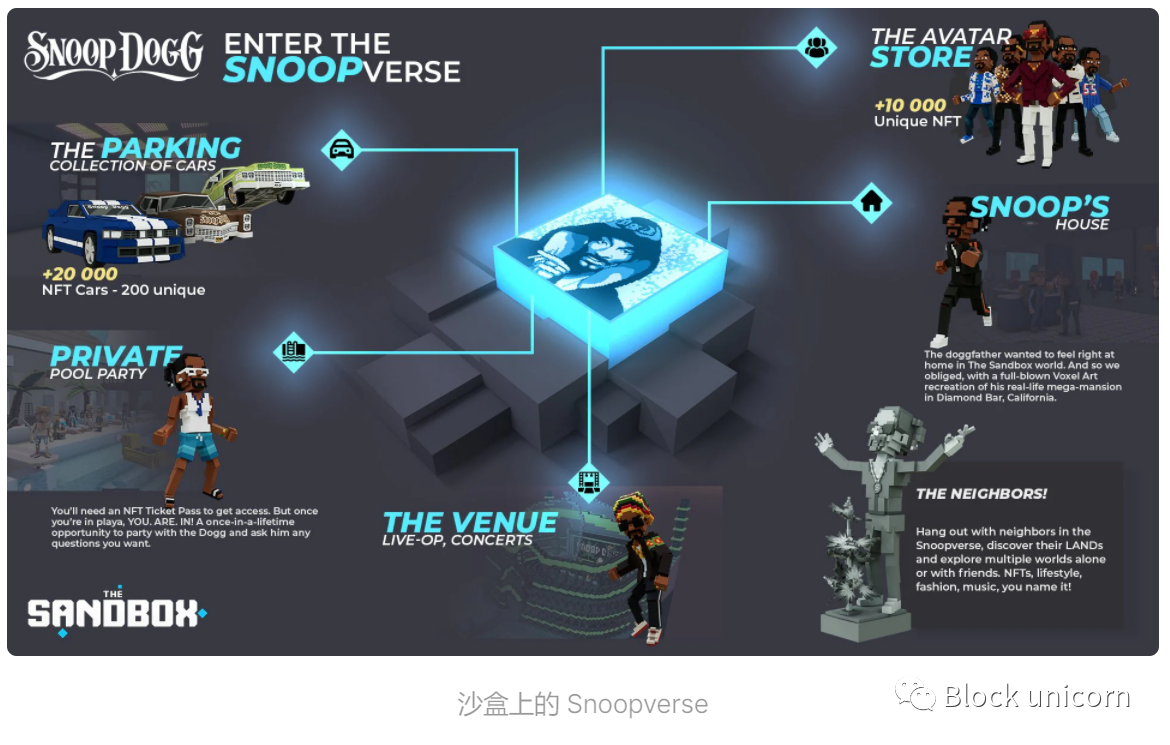
For artists, the incredible thing about this model is that they are able to generate passive income through NFTs, and in Snoop's case, he sells NFT tickets (ie: 1,000 private party passes), 10,000 avatar skins, 20,000 Cars and more to make this happen.
People also care about having access to Snoop, as well as being an active participant and landowner, someone paying up to $450,000 to be Snoop's neighbor in the Metaverse. With only 122 lands and 67 premium lands + NFT bundles, there is an inherent scarcity that drives the market and access to these valuable experiences - like the chance to attend a private ticketed pool party with Snoop and ask him anything you want Ask questions. Selected groups can also purportedly host private Snoop parties in their own Snoopverse lands.
The monetization opportunities in The Sandbox go way beyond skins, and I think these experiences appeal more to an older audience who naturally have more spending power. Unlike the Fortnite or Roblox collaborations, these come with a bit more price tag. I'd like to see more technologies used to open up the Metaverse that enable experiences like rent/share/group-buying to help drive traffic for the average person, and even retroactively reward existing Snoop fans. The latter is difficult to fully verify when transactions are not made on the blockchain, but can prove to be an interesting way of rewarding long-standing top fans.
Lil Nas X vs. Zara Larsson on Roblox
The experience of Roblox artists is similar to that of Fortnite and even Ed Sheeran in Pokemon GO in November 2021. What I'm going to outline in this example is not only the potential of mainstream artists like Lil Nas X, but also the potential of smaller artists like Zara Larsson.
Lil Nas X rose to fame during the pandemic, as an up-and-coming artist saw his song "Old Town Road" become the longest-running No. 1 in US chart history while finding his voice and fame on TikTok , with nearly 27 million followers. While Travis Scott found immediate success in Fortnite, Lil Nas X achieved the same success in Roblox a few months later, becoming the first major concert within the platform. Lil Nas X racked up 33 million views over his two-day/four-show run and reportedly made nearly $10 million in merchandise sales through Roblox. Both Lil Nas X and Roblox have been hugely successful.
More notable for this article is how Zara Larsson found success in Roblox. While still successful with nearly 14 million monthly listeners on Spotify, most wouldn't clarify Swedish pop singer Larsson as a mainstream top artist. For context, Lil Nas X has 53 million monthly listeners, Justin Bieber has 94 million, Ariana Grande has 80 million, Taylor Swift has 60 million, and so on.
In May, Larsson teamed up with Roblox to promote her "Pinster Girl" album with a virtual dance party in the Metaverse. Fans can watch her perform, buy her merchandise for their avatar, take selfies (ie: snap their avatar next to Zara), and go on a virtual scavenger hunt. Her show has attracted 1.6 million subscribers, but more importantly, earned over $1 million in revenue from skin/merch sales alone. Even more impressive, each item can be priced as low as $1—meaning the feat is likely the result of a large number of fans activating, rather than a handful of wealthy fans dropping hundreds of thousands of dollars each.
During the pandemic, an artist like Larsson no longer has to fight for fair pay on streaming platforms to weather the storm, but can turn to virtual by activating her loyal fanbase and finding new ones. Concerts and digital merchandise. "It takes a long, long time and millions of streams to make seven figures from YouTube or Spotify," she noted in a BBC article.
With both mainstream and indie artists embracing the Metaverse, there's a huge opportunity for long-tail artists to embrace their "100 True Fans." For example, I've been a huge Ingrid Michaelson fan for years and have seen her in concert at least 6 times. She won't be playing in a big stadium, but I bet her fans (myself included) will come to see her perform in the metaverse.
It's important to remember that we're very early on seeing artists bring immersive concerts to the Metaverse, and I'm excited to see these expand beyond Roblox and other partner teams within the platform, in 2022 becomes more accessible and prominent. There are still issues to be resolved on a platform level (ie: Ava Max's avatar hilariously fell into a lava pit and died during a performance, which was documented by fans on YouTube), and could be a hand-hold between the artists themselves and their team , but I see a bright future for the intersection of the metaverse and music.
first level title
Open and closed metaverses
The idea of an open metaverse and interoperability
secondary title
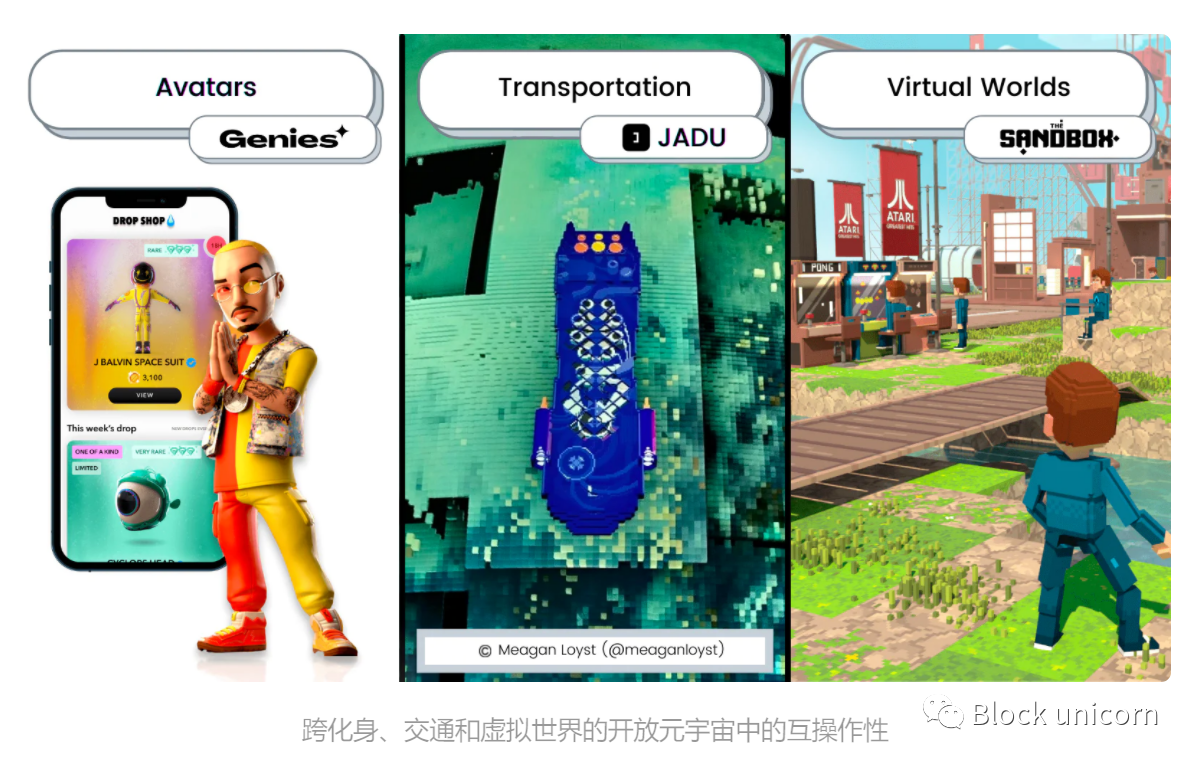
avatar
Using Axie Infinity and the cute NFT monsters people get in the Metaverse as examples, the founders thought that "it's only natural that people should be able to use their Axies in other games too. They're NFTs; they should be open. So It's definitely coming."
Genies, a Metaverse avatar company serving celebrities like Justin Bieber, has a business model that depends on interoperability. They want to create a universal avatar for celebrities (and eventually consumers, currently in closed beta) that can be used in the open metaverse. It simplifies Web3 for artists when performing across domains and creates a unified presence that consumers will recognize (avatars, wearables, etc.). Genies partnered with Warner Music Group earlier this year and signed a partnership with Universal Music Group in December, which means we'll likely see more artists enter the Metaverse starting with their digital avatars in 2022. Genies (Lerer Hippeau portco) are also quick to make their technology more accessible to consumers - I'm excited to be on their waitlist and join their Discord with over 18,000 other Genies fans.
transportation
virtual reality
virtual reality
Perhaps most important, in my opinion, is the ability to bring external NFTs and collectibles themselves into physical spaces and between worlds, such as The Sandbox, Decentraland, and Cryptovoxels. If you're spending $2.7 million on a Bored Ape, chances are you're doing it for the influence, access to an incredible community, and the potential gain on your investment. But I think being able to not only show Ape in a virtual art gallery like Spatial, but being able to walk around in the digital world as Ape and have that be a core part of your identity in the metaverse. The Boring Ape Yacht Club purchased land in the sandbox earlier this year (with plans to potentially distribute the land to community members), so I expect this to come to fruition in 2022, and other NFT projects with strong communities may follow. The Sandbox even owns 31 boring apes of their own (worth ~$9M), so they're investing heavily in making it possible for anyone to "turn a 2D collectible image NFT into a 3D playable animated avatar that can run, jump, socialize, play" games and interact with other peer avatars in their ecosystem".
The Sandbox owns Ape #3749 "The Captain" and wants to make it 3D in the metaverse.
A Closed Metaverse and the Vision of "Big Tech" Companies
Big tech companies like Meta are building "walled gardens" like Horizon Worlds, essentially at odds with companies like The Sandbox. In a decentralized metaverse like The Sandbox or Decentraland, anyone should be able to build, own, and monetize their creations within the metaverse. However, a Meta version of the Metaverse could be similar to Facebook's presence in Web2, where the parent company owns and profits from user data, and consumers are only active participants. The Winklevoss Twins just raised $400 million to build a decentralized alternative to Zuckerberg’s Meta, and the broader crypto community is also skeptical about big tech’s impact on the Metaverse’s future.
first level title
Enterprises in the Metaverse
secondary title
The development of virtual headquarters
In the Metaverse, corporate America (or the corporate world, really) is best represented by the development of a virtual headquarters that brings remote workers together. As the world shifts to remote work due to COVID-19, workers have become accustomed to flexible schedules and hybrid work environments. For big corporations like Facebook, Google, and others pouring millions into building a fun office culture with free lunches, ping pong tables, nap pods, and more...how does this translate to a remote-first future ? Can companies build culture remotely? The answer seems to be the metaverse.
Companies are buying land in Decentraland, The Sandbox, and Cryptovoxels to establish their corporate headquarters in the Metaverse, and they are moving fast. On Christmas Eve, Business Insider detailed how land sales within the Sandbox accounted for a quarter of the $300 million in total NFT sales in the past week. However, the parcels for sale in Decentraland are more expensive - let's call them the "Beverly Hills" of the Metaverse. Of all the top 10 sales in the past week, the most expensive at $758,250, were all digital lands within Decentraland. So what would these virtual headquarters look like?
For Neustreet, it’s a three-story building on a private island in Cryptovoxels that the founders bought for $13,000 and built themselves — complete with co-working spaces, an NFT art gallery, and a venue for events like their office holiday parties. Space in December.
For ConsenSys, the makers of Metamask, they hired an architecture firm to build a virtual headquarters for them in Decentraland in the form of their logo, complete with a floating bar, an amphitheater, and more. They hosted a party in September to celebrate MetaMask reaching 10 million monthly active users, and they plan to host more events in the future.
secondary title
Enterprise Plug and Play Software
Having a corporate presence in the Metaverse doesn't necessarily mean you need to set up a virtual headquarters. Startups like Gather, Teamflow, Virbela, and SoWork are combining video chat with customizable worlds to more closely mimic office environments.
first level title

The Role of NFTs in the Metaverse
secondary title
The Rapid Rise of NFTs
secondary title

So why are people still buying NFTs?
Well, they are virtual art - people collect them like traditional art and want to display them accordingly. They have currency upside (and risk), just like any other investment, and can also be part of a broader artistic portfolio that simply looks beautiful. Aside from the potential utility of Metaverse and other community-facing benefits, people buy them for art/investment. You can view NFTs in a few places:
In the digital world, you often see them as people's profile pictures on Twitter, or displayed in virtual museums/galleries (like Spatial, Lerer Hippeau portco) or virtual worlds (like Decentraland).
secondary title\ (ツ) / ¯ )。
NFTs and celebrities: bringing in the masses
It’s not just the crypto community that’s driving this adoption—celebrities are getting in on the NFT action and bringing their massive fan bases with them.
Paris Hilton talked about NFTs on Jimmy Fallon's Tonight Show and launched a series of her own.
Reese Witherspoon purchased her first NFT in October 2021 and has expressed interest in supporting more female artists launching collections.
Tom Brady launched his own NFT creation/community platform, Autograph, which includes not only his own NFTs, but also NFTs of celebrities such as Naomi Osaka, The Weeknd, Derek Jeter, Tony Hawk, and more.
Martha Stewart (Martha Stewart) is planning a longer-term NFT strategy, launching new series related to seasons and holidays every year-in 2021, she launched a "carving series" on Halloween!
Despite these billion dollar numbers and the crazy momentum we’ve experienced over the past year, we’re still too early in terms of mass consumer adoption of NFTs — as of June 2021, only 2% of Americans (or 400 10,000) have the ability to buy or sell NFT. I spent the Christmas holidays with my extended family and they actually banned me from using the word NFT because they found it annoying (oh well). Trying to explain whether things are fungible or irreplaceable can sometimes feel like a dying enterprise. But NFTs are still very important in bringing the masses into the metaverse, and this is best achieved when combined with culture and often real-life value or experience. I'll detail two of my favorite examples below, each explaining the importance of NFTs in enabling mass migration to the Metaverse.
Adidas: Into the Metaverse
secondary title
Why should we care about this?
Well, first let's consider the signals of these partnerships. When I think of iconic adidas partnerships, I think of their collaboration with Kanye/Yeezy in 2016, and then a few years later, their Beyonce/Ivy Park collaboration in 2019 – the hallmark of collaborations with famous artists Sex and unique collection. Fast forward to 2021 and adidas' much-hyped partnership/collaboration is with the Boring Ape NFT community - and that's a big deal. When bridging the gap with the metaverse, it's important to connect with the community to make the transition as authentic as possible, so this was a smart move by adidas. If you want to read more, I talked about these partnerships and the cultural significance of adidas in the metaverse on Bloomberg TV in December.
It also creates an opportunity for Adidas fans who are simply excited about new merchandise and experiences rather than explicitly crypto or metaverse. At least 9,620 NFTs are reserved for general sale, meaning anyone could theoretically buy an "Into the Metaverse" NFT, whether they're a crypto enthusiast or not. You're essentially getting into an exclusive club, and adidas promises access to both physical and digital products and experiences. It could be a limited-edition hoodie and beanie you wear at the gym, or tickets to an adidas event in the Metaverse, where your NFT is effectively your ticket. Around the same time in December, Nike even bought a company called RTFKT Studios to make NFTs and virtual sneakers—another attempt by a major apparel company to bridge the gap between the digital and physical worlds.
The launch of the NFT collection will continue to provide opportunities to bring dedicated communities into the Metaverse with promised products, communities, and experiences.
Dolce Gabbana
Adidas took a more democratized approach to the market, launching a collection of 30,000 NFTs that more closely resemble tickets. Dolce & Gabbana is taking a slightly different approach when it launches an exclusive collection of just nine NFTs, "Collezione Genesi," in October 2021, with net sales of $6 million and a record for fashion NFTs. Record. Five of these have physical counterparts paired with digital NFTs, and the other four are digital-only NFTs. Every purchase in the collection also promises access to future events.
One day, I dream of attending the MET Gala (not all of us) - what if Anna Wintour decides to launch a Dolce & Gabbana-esque collection where each digital NFT corresponds to a MET Gala ticket? Or the chance to join a community where you helped decide the year's theme? Regardless of the award, the money will still support the Metropolitan Museum of Art, but this time tickets will likely hold value beyond a certain date.
first level title
Closing Remarks: Ideas, Questions and Opportunities
Over the past few days, I've spent hours researching, reading, and now writing about the Metaverse in order to wrap my head around the landscape itself and the opportunities ahead.
Let me start by saying that I am bullish on the Metaverse and think 2022 will be an exciting time when technology, consumers and culture converge - I am excited to invest in the next generation of founders and companies building our virtual future, and here are Several areas of interest:
Infrastructure to support the creation of digital NFTs paired with physical items:As we saw in the Dolce and Gabbana example above, the pairing of digital and physical items can create a magical (and valuable) combination. They co-created and auctioned 9 of their works in collaboration with UNXD, a curated digital culture marketplace. But what if you want to turn your Pokemon card/collectible or your favorite Rolex into an NFT to wear or display? Startups like 4K are doing it for luxury collectibles, but we'll likely see other companies tackling authentication, tokenization, custody of collectibles IRL, and more. Or maybe you're decorating your room with the Metaverse and want to bring a favorite photo of you and your best friend? In Sandbox, you can use their VoxEdit software for creating NFTs for the Sandbox marketplace, but I'd like to see something more akin to Genies, where the items you're creating can be used or stored universally. And I want it to be very consumer friendly - creating NFTs and digital art in general still feels too hard. My non-crypto-native 19-year-old sister makes such beautiful art all over my apartment that I would love to find a way to direct her to create art or NFTs in the Metaverse that she can actually sell.
The intersection of engagement, rewards and loyalty - especially for brands and creators:In 2021, we will see many brands leaping into the Metaverse in various ways. While some are focused on shorter-lived events or experiences, I think many will take a more permanent presence in the Metaverse more seriously—they need technology to help them energize their digital communities. Maybe it could tie IRL to spending with brands in the metaverse and reward customers that way, or create tiered access to certain events based on engagement. I think normal brand/IP holders will have a hard time navigating this, and industry plug-and-play solutions will emerge. Creators and celebrities with large followings, communities, and personal brands can also find success in the Metaverse (as we saw with Snoop Dogg, and others, like Paris Hilton, in her Own World of Paris hosted a New Years Eve event on Roblox - which I attended!) - similar concepts and challenges apply, and I'd love to see more solutions that enable mass adoption. I tweeted about Paris Hilton's presence on Roblox and the importance/role of selfies in the metaverse the other day - think about how she activates her community around selfies in the metaverse, and Create an experience out of it, both inside and outside the Roblox ecosystem (as Paris says...that's hot). Connecting the world and making loyalty work will be huge.
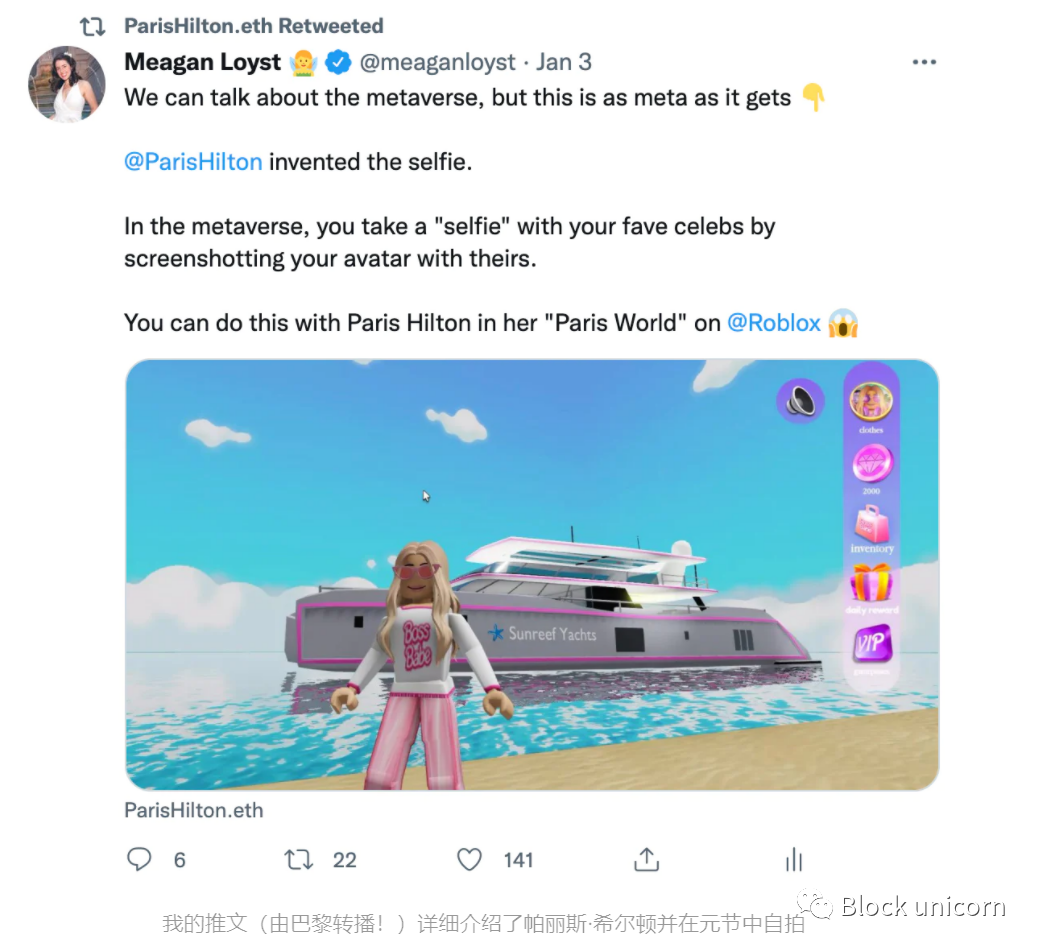
Agnostic tools ecosystem and support for game developers:When I dig into Roblox activations and individual creators/developers with brands, they tend to only focus on one ecosystem (ie: if you develop within Roblox, you're all in Roblox and probably don't spend time on Minecraft earn a living). But regardless of the platform, any developer must consider expanding their game through partnerships, outside legal help, and deal structures, among other things. Perhaps even the IRL monetization opportunities could pair well with virtual representations of their games. The creator economy in Metaverse will undoubtedly thrive, and I would like to see more technology enabling developers to drive these new economies.
New blockchain-based games and assets supporting open Metaverse and interoperability:I'm a big believer in the open metaverse. I think there will be more games with success and community like Axie Infinity, and startups like Jadu connecting avatars and NFTs to a new game or world. I want to be able to easily jump back and forth between worlds without worrying about what I'm bringing. Dematerialization is innovating in the fashion world, and items from their stores can also be found in VRChat, Decentraland, Cryptovoxels, and Somnium Space. I also think that accessibility also plays a role here - bringing in more consumers at affordable prices through leasing, shared ownership, etc. and the technology that supports this shift. For the average consumer just starting out in the cryptocurrency/gaming world, spending a few hundred dollars on Axies might be a burden, rather than getting into Roblox for free.
Temperance in the Metaverse:As we explore new worlds, challenges come with these new discoveries. Distinguishing real people in the Metaverse from admin-run moderators or even AI-generated avatars can pose some problems or questions. The online disinhibition effect explains why people who often exhibit bad behavior online can also hide behind masks, screens or anonymity - as we see in the comments section on TikTok or any real online forum. Naturally there will be bad actors who ruin the experience for others. It will be important to help platforms and startups minimize this through technology and training.
Calculate ability:Especially when it comes to VR, it's still too early for us to even be able to manipulate the headset and the world at high volume. Meta's Horizon n Worlds can only accommodate up to 20 participants, and even traditional Metaverse games like Fortnite can only accommodate 100 to 128 players at once (and that's before VR is included). Intel claims that the Metaverse will require a 1,000x increase in computing power to bring these bold Metaverse visions to life. It will be interesting to see new startups tackling these areas to improve the capacity and overall quality of experience of Metaverse spaces.
In the end, it's a big world, and I mean the metaverse. It expands what is possible for us as consumers - new earning potential and income streams, digital representation of being whoever we want to be, and being in a whole new digital/social way without limits. With COVID, it has been difficult to travel and experience new things - VR and the Metaverse have changed that. In the past two years, I've met more people than I've ever met in my entire life -- all online. The Metaverse means a lot to artists, musicians, governments, big corporations, startups, and more. If the consumer is there, the rest will come. 2022 is going to be a big year for the Metaverse, and I'm excited to live and experience it with all of you.